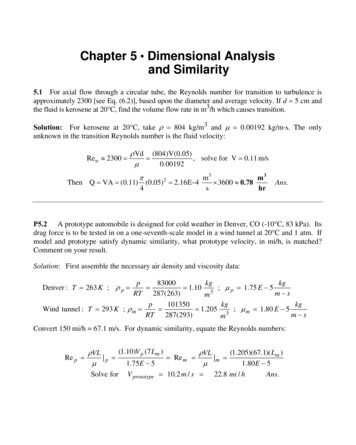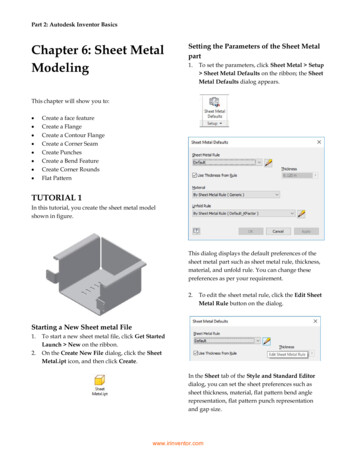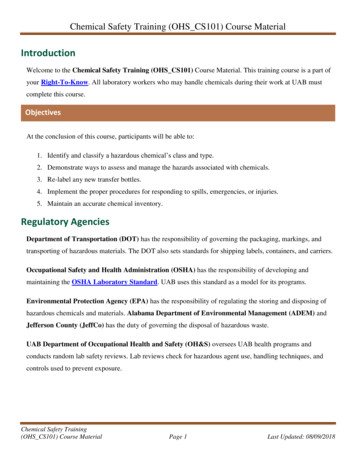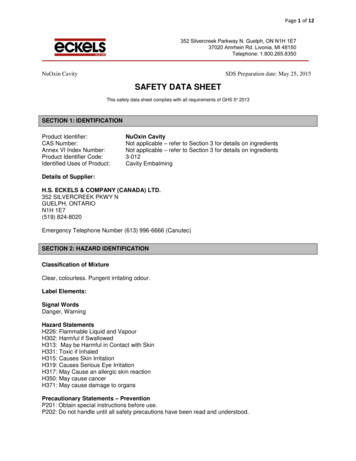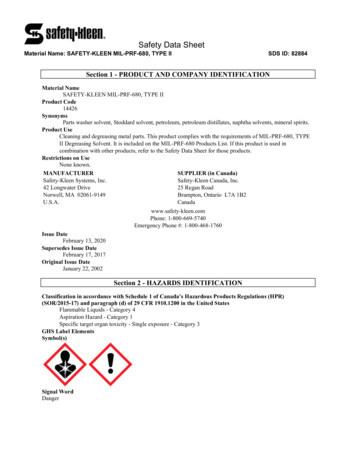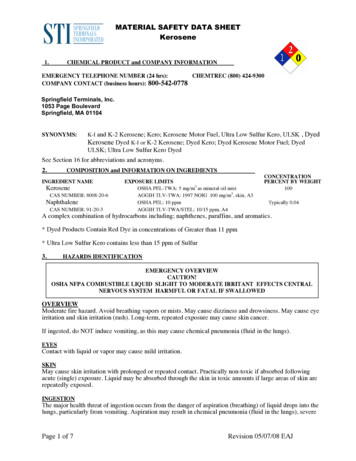
Transcription
MATERIAL SAFETY DATA SHEETKerosene1.CHEMICAL PRODUCT and COMPANY INFORMATIONEMERGENCY TELEPHONE NUMBER (24 hrs):CHEMTREC (800) 424-9300COMPANY CONTACT (business hours): 800-542-0778Springfield Terminals, Inc.1053 Page BoulevardSpringfield, MA 01104SYNONYMS:K-I and K-2 Kerosene; Kero; Kerosene Motor Fuel, Ultra Low Sulfur Kero, ULSK , DyedKerosene Dyed K-I or K-2 Kerosene; Dyed Kero; Dyed Kerosene Motor Fuel; DyedULSK; Ultra Low Sulfur Kero DyedSee Section 16 for abbreviations and acronyms.2.COMPOSITION and INFORMATION ON INGREDIENTSINGREDIENT NAMEKeroseneCAS NUMBER: 8008-20-6NaphthaleneCAS NUMBER: 91-20-3CONCENTRATIONPERCENT BY WEIGHT100EXPOSURE LIMITSOSHA PEL-TWA: 5 mg/m3 as mineral oil mistAGGIH TLV-TWA: 1997 NOIG - 100 mg/m3, skin, A3OSHA PEL: 10 ppmAGGIH TLV-TWA/STEL: 10/15 ppm, A4Typically 0.04A complex combination of hydrocarbons including; naphthenes, paraffins, and aromatics.* Dyed Products Contain Red Dye in concentrations of Greater than 11 ppm* Ultra Low Sulfur Kero contains less than 15 ppm of Sulfur3.HAZARDS IDENTIFICATIONEMERGENCY OVERVIEWCAUTION!OSHA NFPA COMBUSTIBLE LIQUID SLIGHT TO MODERATE IRRITANT EFFECTS CENTRALNERVOUS SYSTEM HARMFUL OR FATAL IF SWALLOWED---OVERVIEWModerate fire hazard. Avoid breathing vapors or mists. May cause dizziness and drowsiness. May cause eyeirritation and skin irritation (rash). Long-term, repeated exposure may cause skin cancer.If ingested, do NOT induce vomiting, as this may cause chemical pneumonia (fluid in the lungs).EYESContact with liquid or vapor may cause mild irritation.SKINMay cause skin irritation with prolonged or repeated contact. Practically non-toxic if absorbed followingacute (single) exposure. Liquid may be absorbed through the skin in toxic amounts if large areas of skin arerepeatedly exposed.INGESTIONThe major health threat of ingestion occurs from the danger of aspiration (breathing) of liquid drops into thelungs, particularly from vomiting. Aspiration may result in chemical pneumonia (fluid in the lungs), severePage 1 of 7Revision 05/07/08 EAJ
MATERIAL SAFETY DATA SHEETKerosenelung damage, respiratory failure and even death. Ingestion may cause gastrointestinal disturbances, includingirritation, nausea, vomiting and diarrhea, and central nervous system (brain) effects similar to alcoholintoxication. In severe cases, tremors, convulsions, loss of consciousness, coma, respiratory arrest, and deathmay occur.INHALATIONExcessive exposure may cause irritations to the nose, throat, lungs and respiratory tract. Central nervoussystem (brain) effects may include headache, dizziness, loss of balance and coordination, unconsciousness,coma, respiratory failure, and death.WARNING: the burning of any hydrocarbon as a fuel in an area without adequate ventilation may result inhazardous levels of combustion products, including carbon monoxide, and inadequate oxygen levels, whichmay cause unconsciousness, suffocation, and death.CHRONIC EFFECTS and CARCINOGENICITYSimilar products produced skin cancer and systemic toxicity in laboratory animals following repeatedapplications. The significance of these results to human exposures has not been determined see Section IIToxicological Information.–MEDICAL CONDITIONS AGGRAVATED BY EXPOSUREIrritation from skin exposure may aggravate existing open wounds, skin disorders, and dermatitis (rash).4.EYESFIRST AID MEASURESIn case of contact with eyes, immediately flush with clean, low-pressure water for at least 15 min. Holdeyelids open to ensure adequate flushing. Seek medical attention.SKINRemove contaminated clothing. Wash contaminated areas thoroughly with soap and water or waterless handcleanser. Obtain medical attention if irritation or redness develops.INGESTIONDO NOT INDUCE VOMITING. Do not give liquids. Obtain immediate medical attention. If spontaneousvomiting occurs, lean victim forward to reduce the risk of aspiration. Monitor for breathing difficulties.Small amounts of material that enter the mouth should be rinsed out until the taste is dissipated.INHALATIONRemove person to fresh air. If person is not breathing, ensure an open airway and provide artificialrespiration. If necessary, provide additional oxygen once breathing is restored if trained to do so. Seekmedical attention immediately.5.FIRE FIGHTING MEASURESFLAMMABLE PROPERTIES:FLASH POINT:AUTO IGNITION POINT:OSHA/NFPA FLAMMABILITY CLASS:LOWER EXPLOSIVE LIMIT (%):UPPER EXPLOSIVE LIMIT (%): 1000F (38 0C) PMCC410 F (2100C)0II (COMBUSTIBLE) (see Section 14 for transportation classification)0.75.0FIRE AND EXPLOSION HAZARDSVapors may be ignited rapidly when exposed to heat, spark, open flame or other source of ignition. Whenmixed with air and exposed to an ignition source, flammable vapors can burn in the open or explode inconfined spaces. Being heavier than air, vapors may travel long distances to an ignition source and flashback. Runoff to sewer may cause fire or explosion hazard.Page 2 of 7Revision 05/07/08 EAJ
MATERIAL SAFETY DATA SHEETKeroseneEXTINGUISHING MEDIASMALL FIRES: Any extinguisher suitable for Class B fires, dry chemical, C02, water spray, fire fightingfoam, or Halon.LARGE FIRES: Water spray, fog or fire fighting foam. Water may be ineffective for fighting the fire, butmay be used to cool fire-exposed containers.FIRE FIGHTING INSTRUCTIONSSmall fires in the incipient (beginning) stage may typically be extinguished using handheld portable fireextinguishers and other fire fighting equipment.Firefighting activities that may result in potential exposure to high heat, smoke or toxic by-products ofcombustion should require NIOSH/MSHA- approved pressure-demand self-contained breathing apparatuswith full facepiece and full protective clothing.Isolate area around container involved in fire. Cool tanks, shells, and containers exposed to fire andexcessive heat with water. For massive fires the use of unmanned hose holders or monitor nozzles may beadvantageous to further minimize personnel exposure. Major fires may require withdrawal, allowing the tankto burn. Large storage tank fires typically require specially trained personnel and equipment to extinguish thefire, often including the need for properly applied fire fighting foam.See Section 16 for the NFPA 704 Hazard Rating.6.ACCIDENTAL RELEASE MEASURESACTIVATE FACILITY'S SPCC, SPILL CONTINGENCY OR EMERGENCY RESPONSE PLAN.Evacuate nonessential personnel and remove or secure all ignition sources. Consider wind direction; stayupwind and uphill, if possible. Evaluate the direction of product travel, diking, sewers, etc. to confirm spillareas. Do not touch or walk-through spilled material. Spills may infiltrate subsurface soil and groundwater;professional assistance may be necessary to determine the extent of subsurface impact.Carefully contain and stop the source of the spill, if safe to do so. Protect bodies of water by diking,absorbents, or absorbent boom, if possible. Do not flush down sewer or drainage systems, unless system isdesigned and permitted to handle such material. The use of fire fighting foam may be useful in certainsituations to reduce vapors. The proper use of water spray may effectively disperse product vapors or theliquid itself, preventing contact with ignition sources or areas/equipment that require protection.Take up with dry earth, sand or other non-combustible, inert oil absorbing materials. Carefully shovel, scoopor sweep up into a waste container with clean, non-sparking tools for reclamation or disposal. Response andclean-up crews must be properly trained and must utilize proper protective equipment (see Section 8). Localand / or Federal notification may be required if this material is released to the environment (see Section 15for additional information).7.HANDLING and STORAGEHANDLING PRECAUTIONSHandle as a combustible liquid. Keep away from heat, sparks, and open flame! Electrical equipment shouldbe approved for classified area. Bond and ground containers during product transfer to reduce the possibilityof static-initiated fire or explosion.Special slow load procedures for “switch loading” must be followed to avoid the static ignition hazard thatcan exist when higher flash point material (such as fuel oil) is loaded into tanks previously containing lowflash point products (such as this product) see API Publication 2003, “Protection Against Ignitions ArisingOut Of Static, Lightning and Stray Currents.-Page 3 of 7Revision 05/07/08 EAJ
MATERIAL SAFETY DATA SHEETKeroseneSTORAGE PRECAUTIONSKeep away from flame, sparks, excessive temperatures and open flame. Keep containers closed and clearlylabeled. Label all secondary containers that this material is transferred into with the chemical name andassociated hazard(s).Use approved vented storage containers. Empty product containers or vessels maycontain explosive vapors. Do not pressurize, cut, heat, weld or expose such containers to sources of ignition.Store in a well-ventilated area. Protect containers from damage and vehicular traffic. Post “No Smoking”signs in product storage areas. This storage area should comply with NFPA 30 "Flammable andcombustible Liquid Code". Avoid storage near incompatible materials. The cleaning of tanks previouslycontaining this product should follow API Recommended Practice (RP) 2013 "Cleaning Mobile Tanks InFlammable and Combustible Liquid Service" and API RP 2015 "Cleaning Petroleum Storage Tanks."WORK/HYGIENIC PRACTICESEmergency eye wash capability should be available in the near proximity to operations presenting a potentialsplash exposure. Use good personal hygiene practices. Avoid repeated and/or prolonged skin exposure.Wash hands before eating, drinking, smoking, or using toilet facilities. Do not use as a cleaning solvent onthe skin. Do not use solvents or harsh abrasive skin cleaners for washing this product from exposed skinareas. Waterless hand cleaners are effective. Promptly remove contaminated clothing and launder beforereuse. Use care when laundering to prevent the formation of flammable vapors which could ignite via washeror dryer. Consider the need to discard contaminated leather shoes and gloves.8.EXPOSURE CONTROLS and PERSONAL PROTECTIONENGINEERING CONTROLSUse adequate ventilation to keep vapor concentrations of this product below occupational exposure andflammability limits, particularly in confined spaces.EYE/FACE PROTECTIONSafety glasses or goggles are recommended where there is a possibility of splashing or spraying.SKIN PROTECTIONGloves constructed of nitrile, neoprene, or PVC are recommended. Chemical protective clothing such as ofEl. DuPont Tychem , Saranex or equivalent recommended based on degree of exposure. Note: Theresistance of specific material may vary from product to product as well as with degree of exposure. Consultmanufacturer specifications for further information.RESPIRATORY PROTECTIONA NIOSH/MSHA-approved air-purifying respirator with organic vapor cartridges or canister may bepermissible under certain circumstances where airborne concentrations are or may be expected to exceedexposure limits or for odor or irritation. Protection provided by air-purifying respirators is limited. Refer toOSHA 29 CFR 191 0.134, ANSI Z88.2-I 992, NIOSH Respirator Decision Logic, and the manufacturer foradditional guidance on respiratory protection selection. Use a positive pressure, air-supplied respirator ifthere is a potential for uncontrolled release, exposure levels are not known, in oxygen-deficient atmospheres,or any other circumstance where an air-purifying respirator may not provide adequate protection.9.PHYSICAL and CHEMICAL PROPERTIESAPPEARANCEPale yellow to water-white liquid, or a Reddish Orange color for Dyed ProductsODORCharacteristic petroleum distillate odorPage 4 of 7Revision 05/07/08 EAJ
MATERIAL SAFETY DATA SHEETKeroseneBASIC PHYSICAL PROPERTIESBOILING RANGE:VAPOR PRESSURE:VAPOR DENSITY (air I):SPECIFIC GRAVITY (H20 1):PERCENT VOLATILES:EVAPORATION RATE:SOLUBILITY (H20):300 to 580 0F (149 to 304 0C)0.4 mm Hg @68 0F (20 0C)AP 4.50.79 0.85100 %Slow; varies with conditionsNegligible-10.STABILITY and REACTIVITYSTABILITY: Stable. Hazardous polymerization will not occur.CONDITIONS TO AVOIDAvoid high temperatures, open flames, sparks, welding, smoking and other ignition sources.INCOMPATIBLE MATERIALSKeep away from strong acids and oxidizers such as nitric and sulfuric acids.HAZARDOUS DECOMPOSITION PRODUCTSCarbon monoxide, carbon dioxide and non-combusted hydrocarbons (smoke).11.TOXICOLOGICAL PROPERTIESACUTE TOXICITYAcute dermal LD5O (rabbits): 2 g/kgPrimary dermal irritation: moderate irritant (rabbits)Guinea pig sensitization: negativeAcute oral LD5O (rats): 5 g/kgPrimary eye irritation: slightly irritating (rabbits)CHRONIC EFFECTS AND CARCINOGENICITYCarcinogenicity:OSHA: NO ARC: NO NTP: NO ACGIH: 1997 NOIC: A3Dermal carcinogenicity: positive (mice)Studies have shown that similar products produce skin cancer or skin tumors in laboratory animals followingrepeated applications without washing or removal. The significance of this finding to human exposure hasnot been determined. Other studies with active skin carcinogens have shown that washing the animal’s skinwith soap and water between applications reduced tumor formation.12.ECOLOGICAL INFORMATION13.DISPOSAL CONSIDERATIONS14.TRANSPORTATION INFORMATIONKeep out of sewers, drainage areas and waterways. Report spills and releases, as applicable, under Federaland State regulations. (See Section 15 for additional information)Consult federal, state and local waste regulations to determine appropriate disposal options.PROPER SHIPPING NAME:HAZARD CLASS and PACKING GROUP:DOT IDENTIFICATION NUMBER:DOT SHIPPING LABEL:Kerosene3, PG IIIUN 1223FLAMMABLE LIQUIDEMERGENCY RESPONSE GUIDEBOOK GUIDE NUMBER: 128May be reclassified for transportation as a COMBUSTIBLE LIQUID under conditions of DOT 49 CFR173.1 20(b)(2).IRS REQUIREMENTS if Dyed, “Dyed Kerosene, Non-Taxable Use Only, Penalty for TaxableUse”Page 5 of 7Revision 05/07/08 EAJ
MATERIAL SAFETY DATA SHEETKerosene15.REGULATORY INFORMATIONU.S. FEDERAL, STATE, and LOCAL REGULATORY INFORMATIONThis product and its constituents listed herein are on the EPA TSCA Inventory. Any spill or uncontrolledrelease of this product, including any substantial threat of release, may be subject to federal, state and/orlocal reporting requirements. This product and/or its constituents may also be subject to other regulations atthe state and/or local level. Consult those regulations applicable to your facility/operation.EPA NOTIFICATION (OIL SPILLS)If the there is a discharge of more than 1,000-gallons of oil into or upon navigable waters of the United States, or if it is thesecond spill event of 42 gallons or more of oil into water within a twelve (12) month period, a written report must besubmitted to the Regional Administrator of the EPA within sixty days of the event.RCRA InformationIf disposed, this product would be considered a hazardous waste under RCRA with an EPA waste code ofD001 for the characteristic of ignitibility.CLEAN WATER ACT (OIL SPILLS)Any spill or release of this product to “navigable waters” (essentially any surface water, including certainwetlands) or adjoining shorelines sufficient to cause a visible sheen or deposit of a sludge or emulsion mustbe reported immediately to the National Response Center (1 -800-424-8802) or, if not practical, the U.S.Coast Guard with follow-up to the National Response Center, as required by U.S. Federal Law. Also contactappropriate state and local regulatory agencies as required.CERCLA SECTION 103 and SARA SECTION 304 (RELEASE TO THE ENVIRONMENT)The CERCLA definition of hazardous substances contains a “petroleum exclusion” clause, which exemptscrude oil, refined, and unrefined petroleum products and any indigenous components of such. However,other federal reporting requirements (e.g., SARA Section 304 as well as the Clean Water Act if the spilloccurs on navigable waters) may still apply.SARA SECTION 311/312 HAZARD CLASSESACUTE HEALTHX-CHRONIC HEALTHXFIREXSUDDEN RELEASE OF PRESSUREREACTIVE----SARA SECTION 313 SUPPLIER NOTIFICATION-This product does not contain toxic chemicals subject to the reporting requirements of section 313 of theEmergency Planning and Community Right-To-Know Act (EPCRA) of 1986 and of 40 CFR 372. However,Polycyclic Aromatic Compounds (PACs) are coincidentally manufactured from the combustion of variousfuel oils and other petroleum products. Under SARA Section 313, the de minims exemption has beeneliminated for PACs and other listed persistent bio-accumulative and toxic chemicals (PBTs). Refer to EPAguidance for additional reporting informationCANADIAN REGULATORY INFORMATION (WHMIS)Class B, Division 3 (Combustible Liquid) Class D, Division 2, Subdivision B (Toxic by other means)16.OTHER INFORMATIONNFPA HAZARD igibleHMIS HAZARD RATINGHEALTH:*1FIRE:2REACTIVITY: 0* CHRONICSlightModerateNegligiblePage 6 of 7Revision 05/07/08 EAJ
MATERIAL SAFETY DATA SHEETKeroseneABBREVIATIONS:AP ApproximatelyN/A Not Applicable Less thanN/D Not DeterminedACRONYMS:ACGIHAmerican Conference of GovernmentalIndustrial HygienistsAPIAmerican Petroleum InstituteAIHAAmerican Industrial Hygiene AssociationCERCLAComprehensive Emergency Response,Compensation, and Liability ActANSIAmerican National Standards InstituteDOTU.S. Department of TransportationEPAU.S. Environmental Protection AgencyHMISHazardous Materials Information SystemIARC Greater thanppm parts per ernational Agency For Research OnCancerMine Safety and Health AdministrationNational Fire Protection AssociationNational Institute of Occupational Safetyand HealthNotice of Intended ChangeNTPNational Toxicology ProgramWHMISOPAOil Pollution Act of 1990PMCCMSHANFPANIOSHSTELWEELU.S. Occupational Safety & HealthAdministrationPermissible Exposure Limit (OSHA)Resource Conservation and Recovery ActRecommended Exposure Limit (NIOSH)Superfund Amendments andReauthorization Act of 1986 Title IIISelf-Contained Breathing ApparatusSpill Prevention, Control, andCountermeasuresShort-Term Exposure Limit (generally 15minutes)Threshold Limit Value (ACGIH)Toxic Substances Control ActTime Weighted Average (8 hr.)Workplace Environmental Exposure Level(AIHA)Canadian Workplace Hazardous MaterialsInformation SystemPensky-Martens Closed Cup MethodDISCLAIMER OF EXPRESSED AND IMPLIED WARRANTIESInformation presented herein has been compiled from sources considered to be dependable, and is accurate and reliable to the best ofour knowledge and belief, but is not guaranteed to be so. Since conditions of use are beyond our control, we make no warranties,expressed or implied, except those that may be contained in our written contract of sale or acknowledgment.Vendor assumes no responsibility for injury to vendee or third persons proximately caused by the material if reasonable safetyprocedures are not adhered to as stipulated in the data sheet. Additionally, vendor assumes no responsibility for injury to vendee orthird persons proximately caused by abnormal use of the material, even if reasonable safety procedures are followed. Furthermore,vendee assumes the risk in their use of the material.Page 7 of 7Revision 05/07/08 EAJ
STORAGE PRECAUTIONS Keep away from flame, sparks, excessive temperatures and open flame. Keep containers closed and clearly labeled. Label all secondary containers that this material is transferred into with the chemical name and associated hazard(s).Use approved vented storage containers. Empty product containers or vessels may
